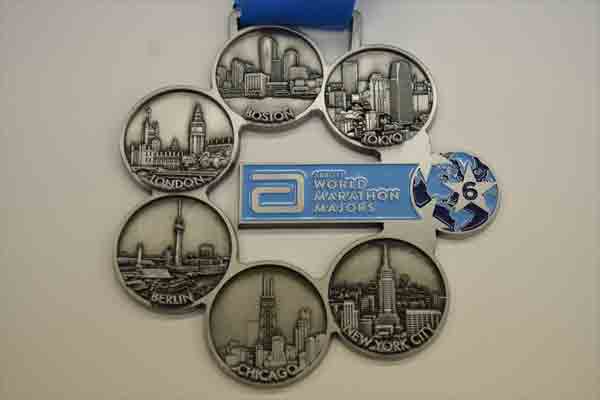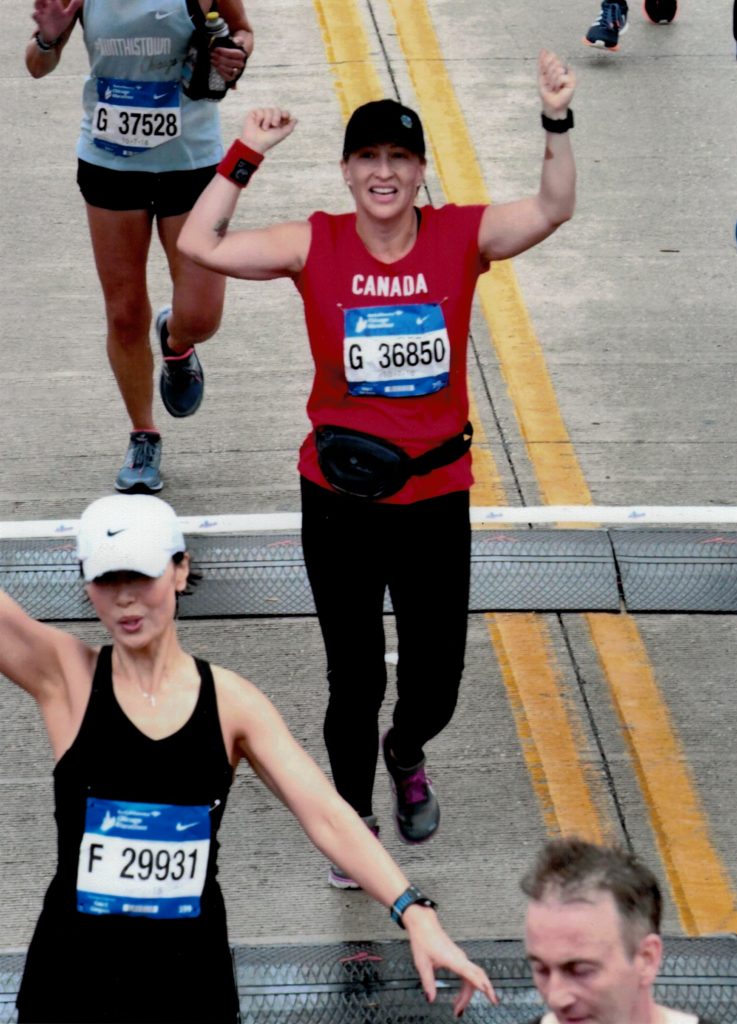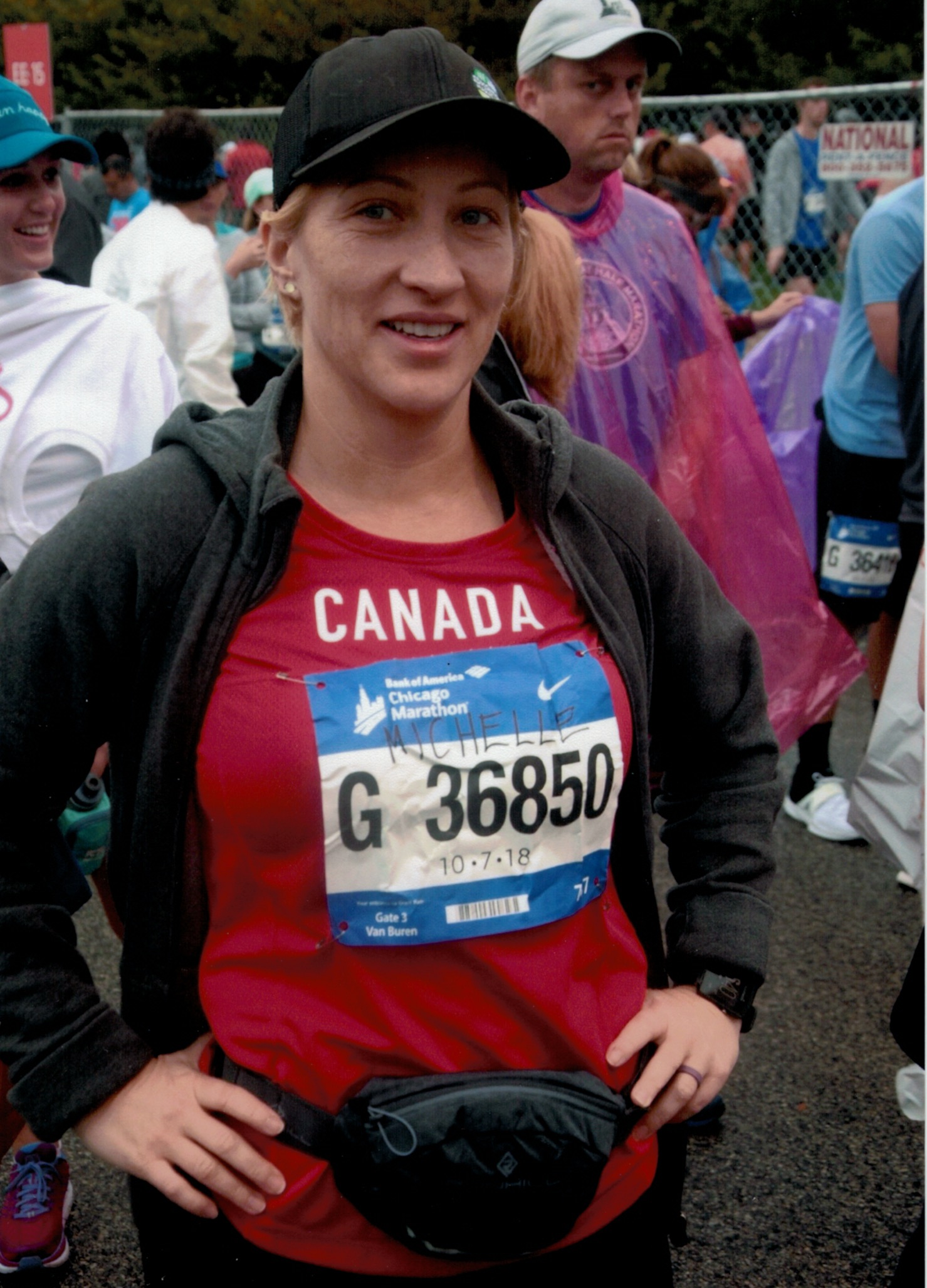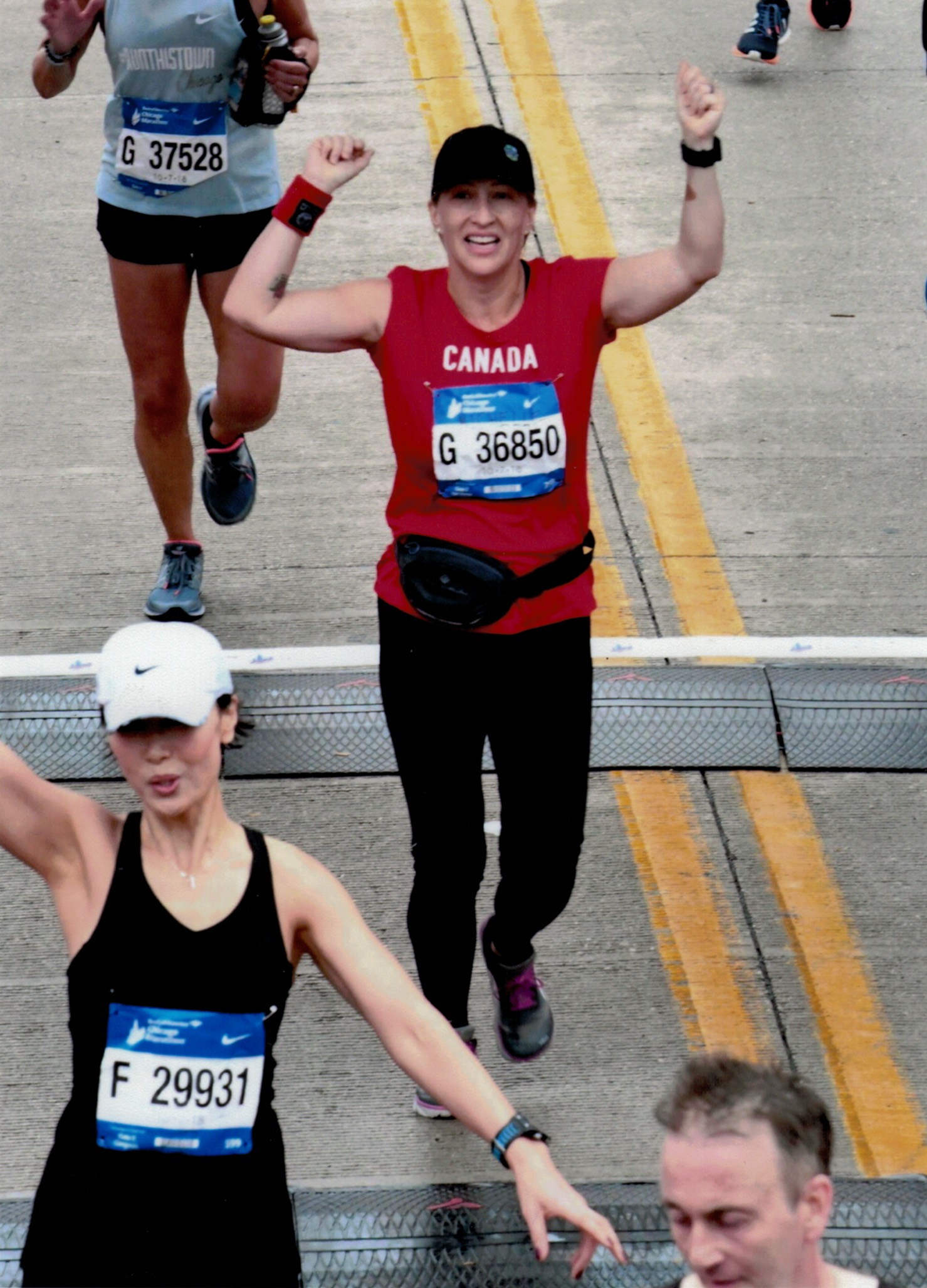The race
On Sun., Oct. 7 of this year, I ran the epic Bank of America Chicago Marathon. If you’re wondering, I finished 14,078th out of a record 44,571 runners who finished the 41st annual marathon this year. Okay maybe I didn’t actually win the race, but I feel like a winner having joined runners who trained and travelled from all 50 states and 100 different countries. We weaved through the streets of downtown Chicago and over 20 historic neighbourhoods including the West Loop, Up Town, Old Town, Logan Square, Lake View, Little Village, South Loop, Pilsen and Lincoln Square. Participants and spectators got to experience the history, culture, renowned architecture and vibrant spirit that make Chicago great.
The Bank of America Chicago Marathon is one of six Abbott World Marathon Majors (WMM). For runners across the globe, competing in a WMM race is a significant accomplishment. The other five majors are Tokyo, Boston, London, Berlin, and New York. The organization delivers several unique benefits to runners; unparalleled experiences – operational excellence at each race ensures a premium race-day journey for runners; Championship Series – professional athletes competing in AbbottWMM qualifying events compete for a prize purse every year; and, advancement of marathoning – AbbottWMM organizers aggressively champion anti-doping protocols and other efforts to move the sport forward.
 Six Star Finisher Medal
Six Star Finisher Medal
In 2017, the Chicago Marathon brought out more that 1.7 million spectators and generated $282 million in economic impact. Since 2002, the race has raised more than $167 million for local, national and global charitable causes. You could see many runners on the course wearing the shirt of some charity that they had committed to training, running and raising money for. There were also categories for wheelchairs, handcycles and athletes with disabilities.
Anyone who has been to a race in whatever capacity, knows that there are pockets of spectators on the sidelines cheering for loved ones and strangers alike. While imagine that for a whole 26.2 miles/42.2 kilometres and in some areas densely packing whole sidewalks. Those signs, encouragement, music, and more, really do help buoy a runner through the tough times.
The course was marked in miles and kilometres. Countless volunteers handed out water and Gatorade and eventually bananas, energy chews and gels. At mile 21.2 there was the Biofreeze Relief Zone, an area where runners could move just off the course and receive external pain relief. Eyes were burning running through that area with the amount of Biofreeze in the air.
The full marathon took place on Sunday and there was also a five kilometre run on the Saturday. A two day race expo took place at McCormick Place, the largest convention center in North America. It consists of four interconnected buildings and one indoor arena. Yeah, we got lost trying to get out of the building. Some of the booths included Altra running shoes, lululemon, Maui Jim Sunglasses and Nike. My husband insists there were hundreds in line at the Nike check out many wanting to pick up Chicago Marathon clothing and the new FlyKnit 4% shoes. The Nike store downtown also had line ups outside the door going down the street. Race medals could be etched for free with your finish time. Attendees of the expo also got the chance to find out how long they could hang with Eliud Kipchoge’s 2:01:39 marathon speed for 200 meters on a 20-foot-long treadmill with some hilarious results (ie face plants). The treadmill is making stops at each of the World Marathon Majors races.
There were shuttle buses to the expo but finding the pick up stop proved difficult. We couldn’t get a satellite signal on our phones due to tall buildings. We walked in circles a bit before finding the bus.
Okay so I didn’t win the race, but who did? In the men’s division, Mo Farah from the UK. He used to run 5,000 and 10,000 m track but retired last year to pursue road racing. This was his third marathon and first U.S. marathon. A new personal record (PR) for him at 2:05:11. The first woman to cross the finish line was Brigid Kosgel from Kenya who finished at 2:18:35.
The days leading up to, and the morning of the race, was rainy. Not ideal and not a scenario I had pictured. I was worried about being wet, cold and slipping. But it didn’t seem to matter and a better option than the weather the following day which was 25C with high humidity.
The race began in Grant Park, located within the city’s central business district. It boosts 319 acres. The start/finish area was about a one mile walk from our hotel. The security was huge. My husband could only go so far with me before I was in a lineup being checked with security wands before being ushered to my corral where we had to stand for some time before our start. The whole day, you could see the security staff, police, Homeland Security and even military personnel.
For the elite runners a blue line is painted on the road marking the shortest route on the course. I tried my best to run here as well but in the end I weaved on the course so much I ran an extra mile +. I read this tip on a Facebook group prior to race day. Another helpful tip was to run on the carpeted areas of bridges to avoid the slippery metal crossings. The course is famous for being flat and fast, a great place to get a PR. It proved to be true until the last 400 m where there was a hill. I believe I muttered, “you’ve got to be kidding me,” at that point.
It’s the first finish line I’ve crossed and felt emotional. Partly because of relief to finally be able to stop running (I had a sore knee and feet by that point), but I also knew I was experiencing a moment that had built up for so long and this was it. As soon as it came it would pass too. They take care of you as you cross the finish line. First there are water bottles, second I had a man read the name on my bib and say, “Congratulations Michelle”, while he placed that race medal over my head. Reportedly Paula Radcliffe was handing out medals at the finish line too. I didn’t see her but Radcliffe is a British long-distance runner who won Chicago in 2002. Next came the bananas, followed by a bag of goodies from Mariano’s that included nuts, protein bars and coupons, then came the special edition Goose Neck beer.
When I got back to the hotel and assessed my condition before getting into a bath, I had four major blisters on my feet and a lot of chafing. Luckily my race package came with some great blister bandaids.
All around the streets post race, you could see people wearing their race shirts and medals. My husband joked that he could pick a runner out by the limping. The restaurants were packed with famished racers. We decided to order in our Chicago deep dish pizza, it took two hours they were so busy. The next day is also known as Medal Monday. So whether you were touring Chicago, headed back home or already back at work, many were proudly wearing their medal.
I’ve mentioned my husband in this blog but a huge shout out to him for being my biggest supporter and #1 fan. He lets me indulge in these travel runs and we truly enjoy each other’s company while experiencing new cities and making lifetime memories. I wouldn’t have achieved all that I have without him.
There was complete live TV coverage and live streaming. I also pre ordered a special edition and package Chicago Tribune. It included the day’s prior paper with articles about the race and special stories from some of the runners and the next day’s paper with race coverage and every runner who finished within six-and-a-half hours had their name in print.
Chicago
Of course the backdrop to the marathon is the City of Chicago itself. By the time we were arriving via cab to our hotel downtown, it was dark. So, all the numerous towers and skyscrapers were lit up creating a magnificent skyline to be greeted with. Chicago’s skyline is among the world’s tallest and densest.
We stayed at Hotel Chicago Downtown. Located within the Marina City complex, it boasts a bowling alley, House of Blues Chicago and a ping pong bar.
Chicago is located on Lake Michigan, the third most populous city in the US with a population of 2,716,450. Metropolitan area has nearly 10 million people.
Landmarks include Millennium Park, Navy Pier, the Magnificent Mile, the Art Institute of Chicago, Museum Campus, the Willis (Sears) Tower, the Museum of Science and Industry, and Lincoln Park Zoo.
We took in two tours when not involved with the expo and run. The first was Untouchable: Chicago’s Original Gangster Tour. A hilarious and informative bus tour where guides are actors and take on the persona of 1920s gangsters. Our gangster guides presented an accurate account of the activities that were going on in Chicago during the 1920s and ’30s (Prohibition Era). We heard the exploits of Capone, Moran, Dillinger and the rest of the boys. Some sites included: the St. Valentine’s Day Massacre, the Biograph Theatre, and Holy Name Cathedral.
We had also booked a river cruise architecture tour. Highly trained and passionate volunteers provide a detailed narrative of Chicago’s various architectural styles and the stories of the people who designed and built the city.
The relaxing 90-minute tour features indoor and outdoor seating. The weather was perfect to sit on deck.
Any traveller who has been to the O’Hare Airport won’t be surprised to hear it is the world’s sixth-busiest airport, serving 79.8 million passengers in 2017. The entire O’Hare International Airport complex resides on over 7,200 acres. The plan is set to add over three million more square feet to the airport’s terminals, a new customs processing center in the Global Terminal, twenty five per cent more ramp space at gates to accommodate larger aircraft, reconstruction of gates and concourses (new concourses will be a minimum of 120 feet (37 m) wide), and increase the gate count from 185 to 235. In 2011, O’Hare became the first major airport to build an apiary on its property; every summer, it hosts as many as 75 hives and a million bees. The bees are maintained by 30 to 40 ex-offenders with little to no work experience and few marketable skills from the North Lawndale community. They are taught beekeeping but also benefit from the bees’ labour, turning it into bottled fresh honey, soaps, lip balms, candles and moisturizers marketed under the beelove product line; products are sold at stores and used by restaurants throughout both Chicago airports. O’Hare has used livestock, primarily goats, since 2013 to control vegetation in harder-to-reach areas or on steeper banks. In the summer of 2018, a mix of 30 goats, sheep, and a donkey named Jackson controlled buckthorn, garlic mustard, ragweed and various other invasive species. The livestock assist not only with vegetation removal and control, but also reduce hiding and nesting places for birds that may interfere with safe aircraft operations, and all without food expense or environmental damage.
There was a very major verdict that was handed down on the Friday that we were in Chicago. The anticipated possible outcome put many on edge and there were many officers on standby downtown near the courthouse. Chicago police Officer Jason Van Dyke was found guilty of second-degree murder in the 2014 shooting of 17-year-old Laquan McDonald.
Van Dyke, was also found guilty of 16 counts of aggravated battery with a firearm. Video of the shooting when it finally was released, led to protests, a Justice Department civil rights investigation, criticism of the mayor and, eventually, the ousting of the police superintendent. Groups of demonstrators took to the streets for several hours after the verdict, chanting, “The people united will never be defeated,” and “Sixteen shots and a cover up.”
City Hall and many downtown businesses closed early in anticipation of protests. Police said there had been no arrests but had the verdict been a different outcome, most likely the protests would have been much more heated. Even leading one to wonder what would have happened to the marathon taking place.
The city had been preparing for possible demonstrations in a case that already sparked protests. The shooting was captured on a grainy police dashcam video. Van Dyke said he fired in self-defense after McDonald lunged at him with a knife. But the dashcam video — which a judge ordered the city to release 13 months after the shooting — showed McDonald walking away from police, rather than charging at them.


